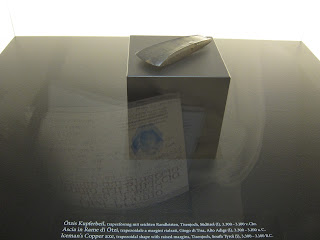Archaeology

Oetzi
the Iceman lived about 3,200 BC. He was 45 years old, had Lyme Disease and
whipworm. He had artherosclerosis and
osteoarthritis, quite badly in the right knee especially. There were multiple tattoos which may have
been an attempt to control and manage joint pain. He was about 5 feet 3 inches tall and weighed
about 110 pounds, was lactose intolerant and had O+ blood type.
Oetzi
was wounded in a defensive fight a few days before his death and had knife cuts
on his hands. He left the valleys near
Bolzano on the Italian side and was heading up an alpine valley. He had stopped to rest and eat a meal of ibex
meat, fat, and einkorn wheat. He was
murdered by being shot from behind: the
arrow went through his left back shoulder causing major bleeding. He fell forward and either hit his head or
was bludgeoned causing skull fractures.
His body and possessions were left buried under ice for 5,000 years
until being discovered by hikers in 1991.
Technical innovations in the Copper Age such
as metal-working brought social change.
Copper mining and smelting and the production of tradeable products
required strict social organization.
Prestigious goods such as copper axe blades were widespread, and their
use as grave goods in particularly well-provisioned graves reflects the
development of ranks in society. Below is Oetzi's copper axe, dating around 3,200 BC and coming from metal originating in southern Tuscany. Since copper was only becoming known in this area by trading with peoples to the south and west, Oetzi was an 'early adopter,' and probably a person of some rank and status.
Already in the Copper Age, graves were showing signs of status and glorifying the image of the dead. Menhirs are slabs of standing stone markers: https://en.wikipedia.org/wiki/Menhir.
Images on Celtic male menhirs are of
weapons, such as axes or daggers. The statue menhirs also give us an idea of clothing in the Copper Age. In the diagram of the menhir to the right, the man is wearing a striped coat with a
fringe visible on the front. He also
wears an elaborate belt. The man’s head
is missing, but a lanyard can be seen around his neck from which a dagger is
hanging.
Copper Age clothing was made of leather or pelts, linen (a material made from flax), tree fiber between the bark and trunk, and in rare cases wool. Spindle whorls to make thread and weights for spinning thread on a loom indicate the manufacture of linen and tree bast clothing. Every family had its own loom to make shirts, skirts, capes and coats. Here is a recreation of what this Copper Age man's clothing may have looked like:
Oetzi’s
‘kit’ or pack was recovered in good shape, along with his body. His ‘kit:’
Clothes: bearskin cap, goatskin leggings, grass cape,
goat/sheepskin jacket.
Shoes: bearskin and linden fiber, hay and leather
Weapons: unfinished yew bow with string of linden
fiber, copper axe, flint dagger
Backpack:
hazelnut and larch, linden string, skin sack
Tools: bone awl, 3 flint tools, stag horn tip tool,
Other: tinder, fungus antibiotic, dried berries,
wheat grains, pouch & belt
You can find out more about Oetzi on the website of the South Tirol Museum of Archaeology: http://www.iceman.it/en/




2 comments:
off white shoes
goyard handbags
bapesta shoes
golden goose outlet
golden goose sneakers
xbft5k79d3
golden goose outlet
golden goose outlet
golden goose outlet
golden goose outlet
golden goose outlet
golden goose outlet
golden goose outlet
golden goose outlet
golden goose outlet
supreme outlet
Post a Comment